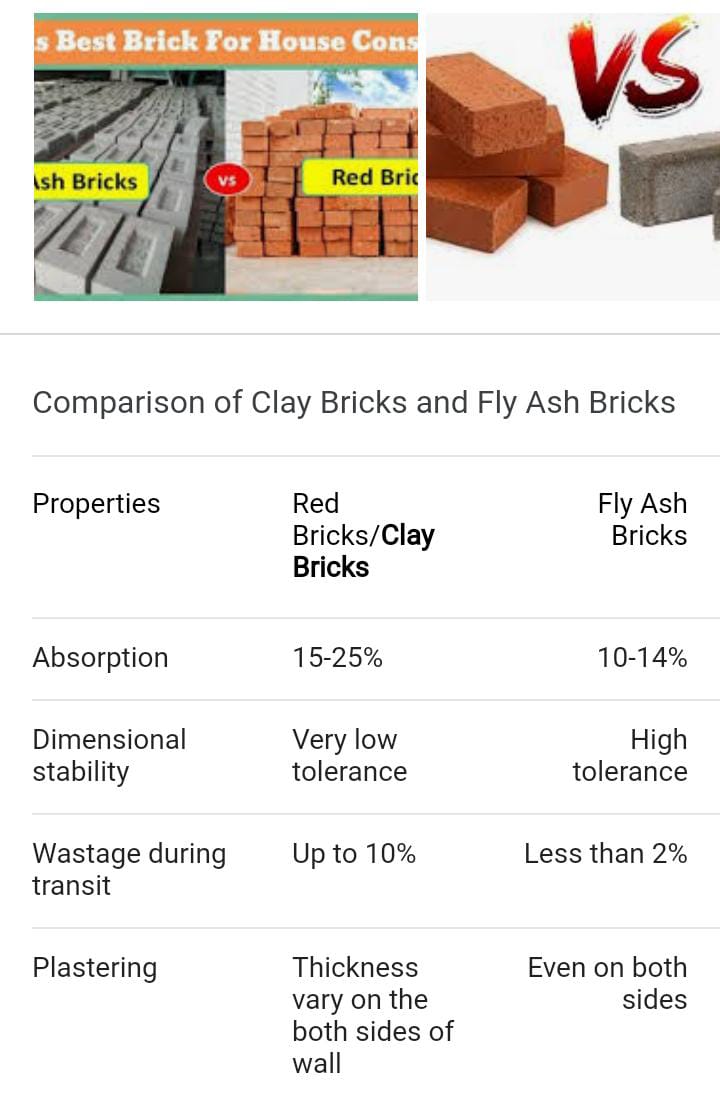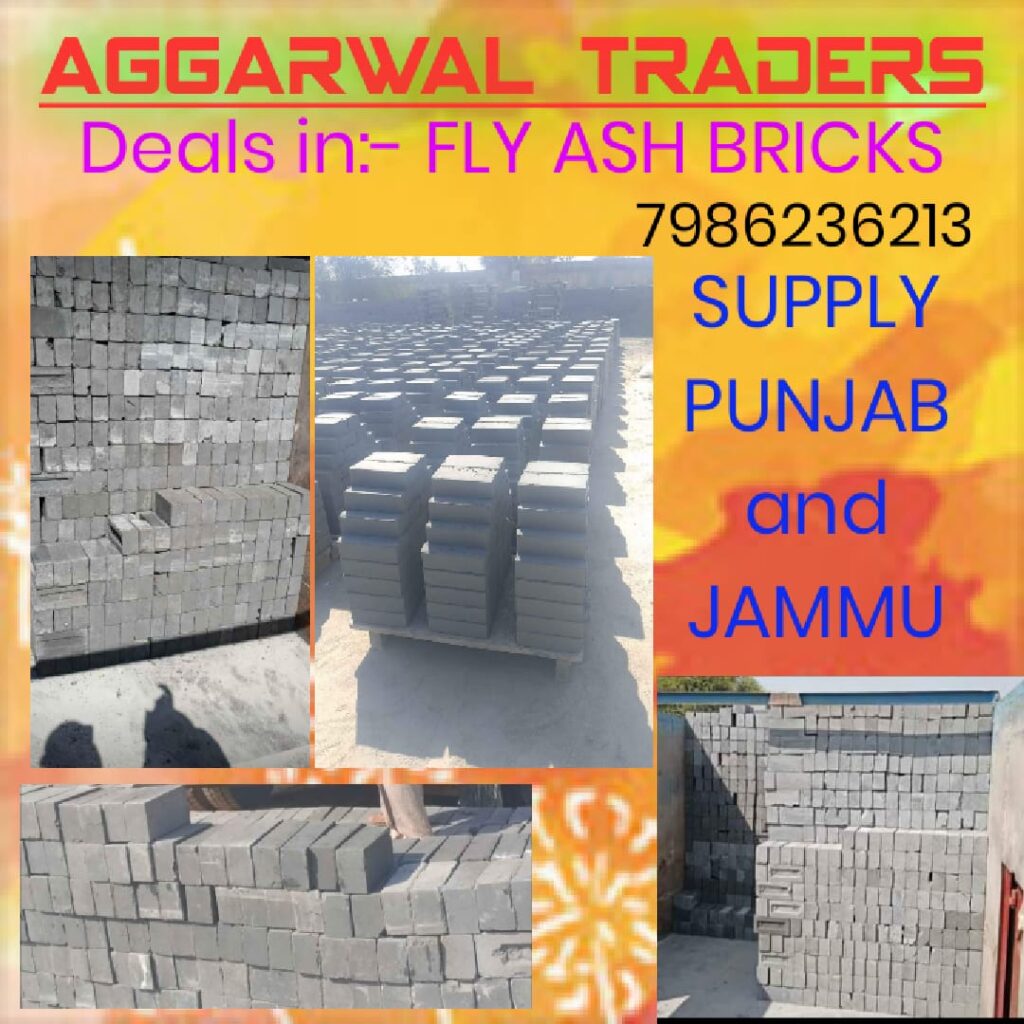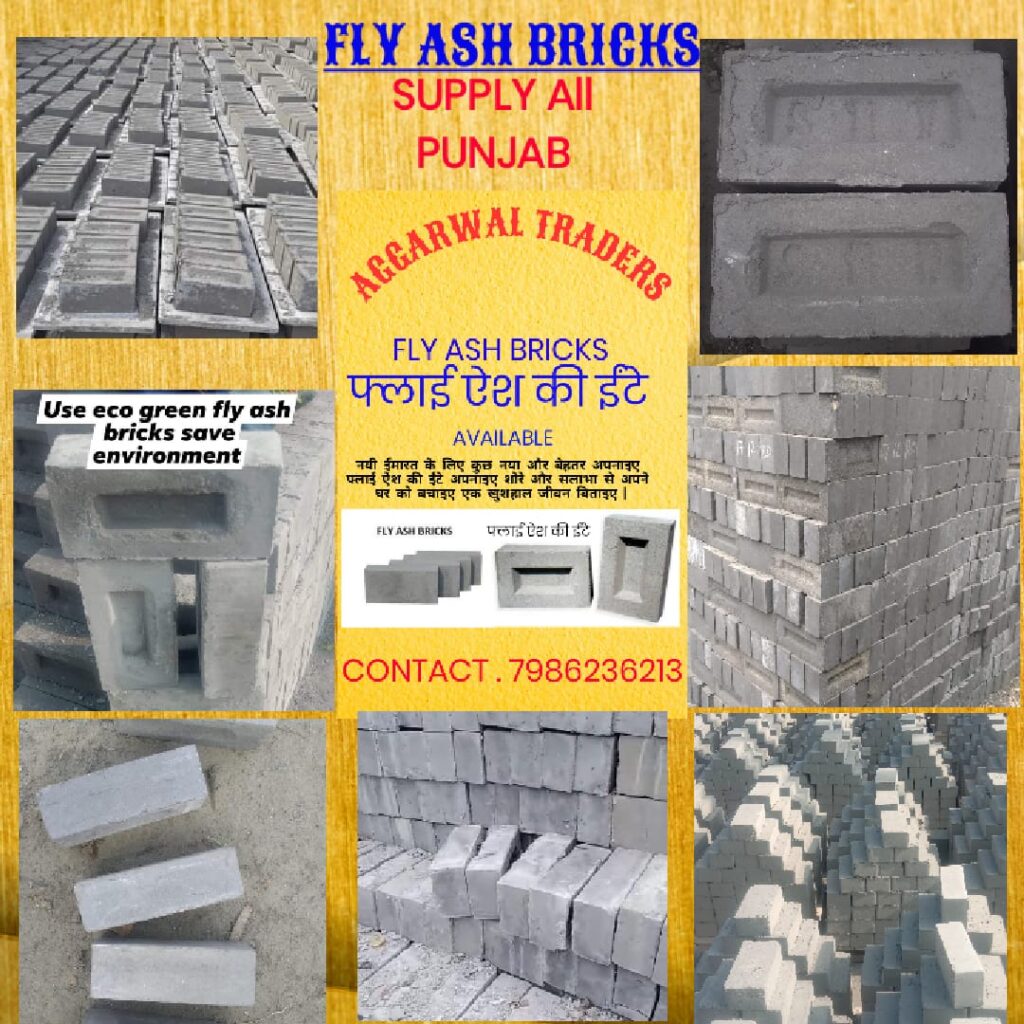ADVANTAGES OF FLY ASH BRICKS IN THE CONSTRUCTION INDUSTRY
ZIRAKPUR (VAIBHAV BANSAL BUREAU CHIEF): Fly ash brick (FAB) is a building material, specifically masonry units, containing class C or class F fly ash and water. Compressed at 28 MPa (272 atm) and cured for 24 hours in a 66 °C steam bath, then toughened with an air-entrainment agent, the bricks can last for more than 100 freeze-thaw cycles. Owing to the high concentration of calcium oxide in class C fly ash, the brick is described as “self-cementing”.
The manufacturing method saves energy, reduces mercury pollution in the environment, and often costs 20% less than traditional clay brick manufacturing. Fly ash bricks are unconventional bricks manufactured from industrial wastes such as fly ash, cement, sand/stone dust. These types of bricks are nowadays used worldwide with gaining popularity over clay bricks.
Fly ash consists of silt-sized particles which are generally spherical, typically ranging in size between 10 and 100 micron (Figure 1-2). These small glass spheres improve the fluidity and workability of fresh concrete. Fineness is one of the important properties contributing to the pozzolanic reactivity of fly ash.
The strength of fly ash brick manufactured with the above compositions range between 7.5 MPa and 10 MPa. Fly ash bricks are lighter and stronger than clay bricks.
Main ingredients include fly ash, water, quicklime or lime sludge, cement, aluminum powder, and gypsum. Autoclaving increases the hardness of the block by promoting quick curing of the cement. Gypsum acts as a long-term strength gainer. The chemical reaction due to the aluminum paste provides AAC its distinct porous structure, lightness, and insulating properties. The aforementioned properties set it apart from other lightweight concrete materials. The finished product is a lighter block, less than 40% the weight of conventional Bricks while providing similar strengths.
The specific gravity stays around 0.6 to 0.65. Using these blocks in buildings reduces the dead load, allowing one to save around 30 to 35% of structural steel, and concrete.
Commercial processes fall into two categories; the lime route, and the cement (OPC) route where the latter is used as a source of lime. In the lime route, the composition is fly ash (50%), slaked lime (30%), and anhydrous gypsum (20%), to which 3 to 4 times of stone dust, sand, or any inert filler material can be added. In the cement route, the composition is fly ash(76%), OPC (20%), and anhydrite (4%), to which 3 to 4 times of filler material can be added.
The following properties of fly ash affect the strength and look of fly ash bricks.
- Loss on Ignition (LOI): fly ash loses weight when it burns at about 1000 °C due to the presence of carbon and water. The weight loss that happens due to carbon combustion and moisture evaporation is called “Loss on Ignition(LOI)”. This is expressed as a percentage. The lower the loss of Ignition, the better will be fly ash. As per BIS it should not be more than 5%.
- Fineness: fine fly ash has more surface area available to react with lime. This increases pozzolanic activity, which contributes to the strength of fly ash bricks. As per BIS it should not be more than 320 m2/kg.
- Calcium (CaO) content: the pozzolanic reactivity of fly ash is more in high calcium fly ash. The greater the pozzolanic activity leads to higher strength of fly ash brick. As per ASTM C618, fly ash is classified into two types: Class C contains more than 10% lime and Class F fly ash contains less than 10% lime.
Based on boiler operations, fly ash can be additionally classified as LT (low temperature) and HT (high temperature). LT fly ash containing amorphous phases is generated where boiler temperature is not more than 800 °C, whereas HT fly ash containing glassy reactive phases is generated at more than 1000 °C in super thermal plants. LT fly ash reacts well with lime whereas HT fly ash reacts well with OPC.
History
Coal dust has historically been collected as a waste product from homes and industry. During the nineteenth century, coal ash was taken by ‘scavengers’ and delivered to local brickworks, where the ash would be mixed with clay. The income from the sale of ash would normally pay for the collection of waste.
Clay is typically entrapped during the formation of coal. When coal is burnt, the incombustible clay particles are left behind as ash. In grate boilers, incombustible ash agglomerates as cinders through prolonged residential time. Nowadays, pulverized coal technology is preferred due to its improved energy efficiency. In this case, the ground clay escapes along with flue gases, settling as ash in bag filters or electrostatic precipitators (ESPs). This gives rise to the name ‘fly ash’.
ADVANTAGES OF USING FLYASH BRICKS
They are light in weight and hence are very suitable for multi-floored buildings. This is because as the height of the buildings increase, the stress and tension on the foundation and structure increase too. With light bricks, this stress and tension are reduced manifold. Fly ash bricks absorb less heat and considering the Indian climate, it makes it better when compared to clay bricks.
From the cost front, it requires less mortar during construction. Further, the machine requires less labor too. These machines are made keeping in mind the costs associated with water wastage and raw material wastage too. Hence save in the breakage front (15%), the plaster and jointing front (15%), and the curing and labor front (7%). So Q Green fly ash brick machines reduce the overall costs.
The compressive strength is very high and they are less porous. They absorb less water and saves cost there, as well.
It is environmentally friendly and hence allows construction businesses to take a step towards sustainable development. Flyash manufacturing machines are green machines too, that promote environmental protection and conservation. Production of fly ash bricks requires no fossil fuel and hence does not lead to the emission of greenhouse gases.
Production of clay bricks damages the topsoil and this is prevented in the manufacturing process of fly ash bricks. There is no pollution or environmental damage, as a result of which it has been put into the white category of products.
Fly ash bricks are stronger, more uniform, and denser as compared to clay bricks. While their mortar consumption is low, their wastage is only about 1% as against that of clay bricks which are about 10%.
These are some advantages of using fly ash bricks that are making major construction houses, and for that matter, even the government, move towards it.
WATCH AN INTERESTING VIDEO ON THE MANUFACTURING PROCESS OF CONCRETE FLY ASH BRICKS
Advantages Of Fly Ash Bricks:
1. Appearance:
The appearance of fly ash bricks is very attractive due to their pleasing color like cement, uniform size, and smooth finish. Due to uniform size, mortar required for walls and plastering reduces almost by 40-50%.
Plaster of Paris (Gypsum plaster), putty can be applied directly without a baking coat of plaster. These bricks are free from cracks, wrap age, organic matter, pebbles, and nodules of free lime.
2. Strength:
The compressive strength of fly ash bricks is very high (9-10 N/mm2). Due to high strength no breakages/wastages during transport and handling. The lower thickness of joints and plaster reduces cracking in plaster.
These bricks do not cause any extra load for the design of structures and provide better earthquake resistance. It improves strength over time and offers greater strength to the building.
3. Thermal Properties:
The thermal conductivity of fly ash bricks is 0.90 – 1.05 W/m2. They absorb less heat. The pozzolanic reaction between fly ash and lime produces less heat. It keeps your building cooler in summer, hence most suitable for Indian climates
4. Durability:
These bricks are highly durable and less permeable. The lower permeability can efficiently reduce the effect of efflorescence on bricks.
These bricks are less porous, absorb less water, and reduce dampness on the walls. It is also highly resistant to attack by mild acid, water, and sulfate.
5. Sound Insulation:
Construction with these bricks provides decent sound insulation to the building.
6. Fire Resistance:
These bricks are highly fire-resistant compared to normal clay bricks.
7. Sustainability:
Fly ash bricks are environmentally friendly as they are made of waste materials that come from the combustion of coal in thermal power plants. There is no pollution or environmental damage, considered as a white category product.
8. Buildability:
These bricks have easy workability and absorb less water. Unlike clay bricks, they do not require soaking in water for 24 hours. The sprinkling of water before use is enough.
The construction technique is the same as clay brick construction and does not require any extra training for the masons.
9. Availability:
These bricks are generally available closer to the thermal power plants. However, finding dealers in all major cities and towns wouldn’t be a problem.
10. Cost:
The same number of fly ash bricks will cover more areas than clay bricks. Consumption of mortar is also low. Requires less labor. The cost is approximately 30% lower than clay bricks.
11. Applicability:
Due to their lightweight, these bricks are suitable for multi-story structures. Less weight means less stress on the building. These bricks can be used in load-bearing external walls in low/mid structures, non-load bearing internal walls in low/mid structures, and non-load bearing internal or external walls in highrise buildings.


Disadvantages
- Depending on the mixture mechanical strength can be low. This can be partially rectified by adding marble waste or mortar between blocks.
- Large size can have more breakages depending on the mix of materials.
- It has high thermal conductivity. Extra insulation is required in colder regions.
Fly Ash Bricks Uses:
Fly ash bricks are used in
i) Multistorey structures.
ii) High-rise buildings.
iii) House construction.
iv) Factories.
Benefits of Fly Ash Bricks for the Environment
The increase in greenhouse gases, out of which CO2 is one of the major constituents, increases global warming year after year, causing drought and floods. The total CO2 Emissions globally account for 24,960 million tons at 1990 levels. The cement and building materials industry is one of the major contributors.
The CO2 emission is about ninety million tons out of cement and forty-nine million tons out of clay bricks production in India. As per the ongoing practices in India, each million clay bricks consume about 200 tons of coal (or any other fuel with an equal quantity of thermal values) and emit around 270 tons of CO2.
Fly ash bricks production in an energy-free route saves the emissions totally, befitting the project to qualify under Clean Development Mechanism (CDM), as envisaged by the Kyoto Protocol towards the welfare of Mother Earth.
In a special interview with our technical journalist Er Vaibhav Bansal, Owner of firm M/S Aggarwal Traders located at Zirakpur Mr. Mukesh Aggarwal manufacturing these bricks told that Aggarwal Traders is working strongly towards creating a Green India, and through our machines, we sought to promote Green Technology in Construction Industry and also provide people an opportunity to convert ‘Waste Into Wealth’.
We have mastered the art of brick making successfully by manufacturing bricks and blocks using 70-80 % Fly ash. We are supplying ready-to-use finished bricks throughout the state of Punjab & Jammu-Kashmir.
TO KNOW ABOUT THE AUTHOR CLICK THE LINK BELOW







